Non - Xeriscape.
Common Landscape Plants. Shrubs, Flowers, & Trees.
For The Arizona Desert Environment
Pictures, Photos, Images,
Descriptions, & Reviews.
Pecan Tree, Carya illinoinensis.
We Are Proud Of Our SafeSurf Rating!
Click On Any Of The Following Links By Amazon.Com
To View Tools For Desert or Arizona Gardening. No Obligation!
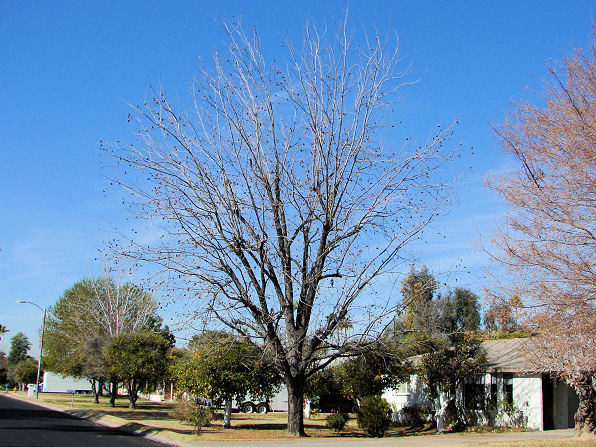 |
| Pecan Tree, Carya illinoinensis. North Central Phoenix, Arizona. January 26, 2006. Pecans Still On The Tree! Yum!! |
|---|
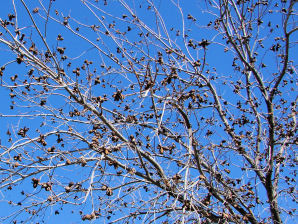 | 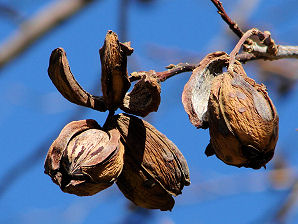 |
| Pecan Tree, Carya illinoinensis. | Pecan Tree, Carya illinoinensis. |
|---|---|
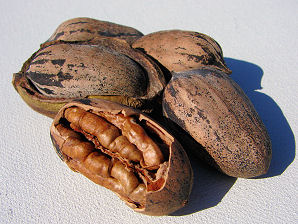 |  |
| Pecan Tree, Carya illinoinensis. Pecan Nuts, Thin Shell. | Pecan Tree, Carya illinoinensis. Pecan Nut, In Husk. |
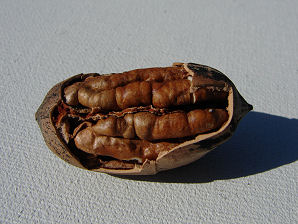 |  |
| Pecan Tree, Carya illinoinensis. Pecan Nut, Meat. | Pecan Tree, Carya illinoinensis. Pecan Nut, Meat. |
Pecan Tree.
We wish to thank Wikipedia, the free encyclopedia for some of the information on this page. We share images and information with Wikipedia. The pecan Tree, Carya illinoinensis, is a species of hickory, native to south-central North America. It also is native to Mexico from Coahuila south to Jalisco and Veracruz. "Pecan" is from an Algonquian word, meaning a nut requiring a stone to crack. Pecans are large, long-lived trees with upright, vase-shaped crowns. Pecans are the largest orchard trees in the USA, reaching 60 - 80 feet tall. The leaves are odd-pinnately compound, with generally 7 to 17 leaflets. Leaflets are lanceolate to obovate, with the proximal half of the blade generally smaller than the distal half (asymmetrical); margins serrate. The Flowers of Pecans are monoecious; male inflorescences are pendulous spikes commonly referred to as catkins. Catkins appear to be borne in groups of 2-3 laterally on 1-yr wood, but are actually produced on extremely short, aborted shoots of current season's growth. Catkins are 2-6" in length, and are shorter in protandrous than protogynous cultivars (see below). The female inflorescences are also spikes, born terminally on current season's growth. Both male and female flowers are green in color, with individual flowers about 1/8" in size. Flowers are incomplete, and both sexes lack petals and sepals. The males are basically groups of anthers subtended by bracts, and the females are merely an ovary with large, feathery stigma at the distal end, having almost no length of style in between. The ovary wall is fused to bract or involucre tissue in females, and the outer ovary wall plus the involucre become the fleshy shuck of the fruit. Pecans, walnuts, and many other nut crops are wind pollinated, and the pollen may travel for miles on a strong wind. Also, each catkin, or male inflorescence, contains over one million pollen grains, and it only takes one to pollinate a female flower and make a nut. Pecan nuts are borne in terminal clusters of 2-10 individuals terminally on the current season's growth. The green, fleshy shuck is composed of bract and ovarian tissue (exo- and mesocarp), and surrounds the nut until maturity. The shuck dehisces along 4 regular sutures, unlike walnuts which lack sutures. Nuts are ovoid, 1-2 inches long, containing a large embryo composed mostly of two cotyledons or kernels. Nut size ranges from 27-100 nuts/lb; "good" size is considered 50 nuts/lb. Cotyledons are separated by a thin, papery central plate extending from the inner layer of the endocarp. Fruiting occurs 4-6 years after transplanting, although maximal yields may not be achieved for 20 or more years. Alternate bearing is common in pecan. This is when the tree bears a large crop one year, followed by a small crop the next. This is a natural tendency in pecan and many nut trees. Pecans, produced by the trees, are a native North American crop. Early Native Americans, as well as European settlers, harvested pecans by throwing sticks into the trees, knocking the nuts to the ground.
Today, pecans are a multimillion-dollar industry. Rural landowners in the Southwest and Southeast grow pecan trees in large groves or woodland pastures. In 1999, U.S. pecan production was about 342 million pounds and worth nearly $448 million. Georgia, Louisiana, Texas, New Mexico and Arizona are the top five pecan-producing states. The pecan industry depends on new tree varieties being developed by plant breeders who work for the USDA's Agricultural Research Service (ARS). These scientists make improvements in the trees to help them overcome diseases. All ARS pecan varieties are named after the various Native American tribes. Some of the early plantings of pecans in Arizona were made in the late 1920s to mid-1930s. Arizona reported 4,000 acres of pecans in 1932, with about 5% of the trees bearing pecans. There were no reports of pecan yield in Arizona until the mid-1970's when plantings made in the early 1960s came into production. In the 1980s more pecan trees were planted in Arizona than in New Mexico; however, in the late 1980s some acreage was abandoned in Arizona due to high water costs. Most pecan plantings in California were made in 1980; the average tree age in 3,500 acres planted is about 18 years. Five of the top 10 pecan-producing counties in the United States are located in the western region of Texas, New Mexico, California, Arizona. Pima and Pinal counties in Arizona are ranked in the top ten counties ( U.S. Department of Commerce, 1992 ). The pecan tree ( Carya illinoensis ) is about as American as a tree can get. Archeological evidence shows that native Americans in the area of Texas used pecans more than 8,000 years ago. The name comes from the Algonquin word "pacane" meaning "nut so hard as to require a stone to crack." Pecans are native to the United States, and crow birds may have contributed to their selection and distribution by carrying the thin-shelled nuts over several miles. When given sufficient space to grow, the pecan can grow to about 100 or 120 feet, making a large deciduous tree with an upright, vase-shaped crown. The trunk diameter can reach 3 to 4 feet. It tends to have a relatively short, bare trunk before its many forked branches appear. The national champion pecan resides in Weatherford, Texas, boasting a height of 91 feet, a crown spread of 120 feet, and a circumference of 257 inches. Pecans need deep, well-drained soil with a good steady source of water. A mature pecan can require more than 2,000 gallons of water a week. The soil must drain well for the tree to thrive. Pecans have dark yellow-green leaves that are smooth to slightly hairy on top. The color pales slightly on the underside. The alternate, compound leaves are in clusters 12 to 20 inches long with nine to 17 leaflets that are 3 to 8 inches long and 1 to 2 inches wide. The tree's flower goes unnoticed by most people. That's because the female flower is a small terminal spike on the end of the current season's growth. The pollen needed to turn these flowers into pecan nuts comes from the male flowers or "catkins," 5- to 6-inch pendulous spikes growing laterally on year-old wood. Pollination is made more difficult by the fact that a tree's male and female flowers are usually not in bloom at the same time. Some varieties shed pollen from the male catkins before the female flowers are receptive, and so require pollen from another variety with a later pollen maturation date. Pecan nuts grow in clusters of 3 to 11 with thin husks that split into four sections, often staying on the tree after the nut has fallen. The nut is light reddish-brown with irregular black or darker-brown blotches. Pecans in the shell are 1 to 2 inches long, with a large embryo composed mostly of two very tasty kernels separated by a thin, papery central plate. The pecan makes a wonderful shade tree in any home landscape that's large enough to accommodate the tree. The newer pecan varieties produce what are called "papershell" pecans-a thin shell you can break with your fingers and that contains nut meat much larger than that from native trees. Most varieties grown for home use begin to produce some nuts in about three years. Most produce well in 4 to 6 years. Once established, a tree will average about 20 pounds of pecans per year, but with good management and growing conditions that can increase to 70 or 100 pounds per tree. Plant and care for your pecan in the same manner that you would any large shade tree. The biggest mistake homeowners make is not giving the tree enough room. In a yard, pecans should be planted at least 60 to 80 feet from any other tree or structure. Its massive root system reaches out a good distance past its drip line. Pecan trees planted in orchards can start at about 30 trees per acre and over time be thinned down to seven. New orchards can begin harvesting pecans about four to six years after transplanting, although maximum yields may not be achieved for 10 years or more. Starting a brand new pecan orchard takes some serious patience and major financial security, but it does pay off. Orchard yields generally range from 800 to 1,200 pounds per acre but can reach as high as 2,500 pounds. Pecans require well over 200 frost-free days for nuts to reach maturity, therefore, pecan production in the United States is pretty much restricted to the southern states, Arizona, and California. Pecans are usually harvested from mid-October through November when the shuck loosens from the shell or splits. The trees in commercial production are harvested with trunk or limb shakers that literally shake the nuts off the tree. Pecan and other hickory woods are rated as the number three hardwood group in the United States. Carya illinoensis has close-grained, hard wood that is pale reddish-brown with occasional dark streaks. As a relative in the hickory family it is sometimes used for smoking meats and cheese. There are over 1000 pecan cultivars documented in the literature, but four make up over 50% of the orchard cultivation in the USA. 'Stuart' is the leading cultivar in the southeastern USA, making up 22-26% of production. 'Desirable' is moderately scab resistant, and accounts for 9-11% of US production. 'Western', also called 'Western Schley', is the most popular cultivar in the western USA. It makes up 12-15% of US production. 'Wichita' is second to �Western' in importance from Texas westward, accounting for 7-11% of production. �Desirable' and �Wichita' are two of the most popular cultivars in the USA.
Quick Notes:
Height: Up To 60 - 80 feet. Some can reach 120 feet. Spread may reach 50 feet.
Flowers: Monoecious; the female flower is a small terminal spike on the end of the current season's growth. Male flowers or "catkins," are 5 to 6 inch pendulous spikes growing laterally on year-old wood.
Flowering Time: February - April.
Leaves: Alternate, compound leaves in clusters 12 to 20 inches long with 9 to 17 leaflets that are 3 to 8 inches long and 1 to 2 inches wide.
Stems/Trunks: Up to 6.6 feet in diameter. Most are about 3 feet.
Soil pH requirements:
Sun Exposure:
Elevation: Can be found growing from 0 - 3,500 feet in Arizona. Usually under 2,400 feet. We have seen most at 1,200 to 1,700 feet. Said to grow best from 3,000 to 4,351 feet.
Habitat: In native Australia it is a common component of watercourse-fringing vegetation in inland arid areas of eastern Australia. Ornamental in lower elevations or Arizona.
Miscellaneous: Flowering Photos Taken January 21, 2006. Arrowhead Ranch, Glendale, Arizona. Statewide in Arizona. Very common low water use landscaping plant in the Phoenix and Tucson areas.
|
We Are Proud Of Our SafeSurf Rating!
Click On Any Of The Following Links By Amazon.Com
To View Tools For Desert or Arizona Gardening. No Obligation!
| © 1966 - Present, Audrey, Eve, & George DeLange |





